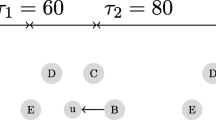Abstract
In Conventional Deformation Analysis (CDA), at least two different epochs are adjusted by using the Least Squares Estimation (LSE) method and compared statistically. The effect of the geometry of the network is an essential part of the adjustment model and the LSE method smears the effects of the displaced point over the other nondisplaced points. In this study, to remove these spoiling effects and to increase the reliability of the deformation analysis, a new approach is introduced. This approach depends on the analysis of the differences between observations of the two epochs, and also considers the principles of the model error approach. All possible combinations of the differences of the observations are considered as model errors in Gauss-Markov model and the estimated model error for the combination, that has the smallest variance, is compared with a critical value to answer the question whether it is significant or not. To compare the results of the new approach with the CDA, the Monte Carlo simulation technique and mean success rate are used in a leveling network. As a consequence, according to the simulation results, the new approach is better than the CDA by 7.6% and 9.7% for one and two displaced points, respectively, when the deformation network is designed as a subnetwork.
Similar content being viewed by others
References
Aydin C., 2012. Power of global test in deformation analysis. J. Surv. Eng.-ASCE, 138, 51–56.
Baarda W., 1973. S-Transformation and Criterion Matrices. Publications on Geodesy, New Series, Vol. 5, No. 1, Netherland Geodetic Commission, Delft, The Netherlands.
Caspary W., 1988. A robust approach to estimating deformation parameters. In: Chrzanowski A. and Wells W., (Eds), Proceedings of the 5th Canadian Symposium on Mining Surveying and Rock Deformation Measurements. Department of Surveying Engineering, University of New Brunswick, Fredericton, NB, Canada, 124–135.
Caspary W.F. and Borutta H., 1987. Robust estimation in deformation models. Surv. Rev., 29, 29–45
Caspary W.F., Haen W. and Borutta H., 1990. Deformation analysis by statistical methods. Technometrics, 32, 49–57.
Chen Y.Q., 1983. Analysis of Deformation Surveys. A Generalized Method. Technical Report No. 94. Department of Surveying Engineering, University of New Brunswick, Fredericton, NB, Canada.
Chen Y.Q., Chrzanowski A. and Secord J.M., 1990. A strategy for the analysis of the stability of reference points in deformation surveys. CISM J., 44, DOI: https://doi.org/10.1139/geomat-1990-0016.
Chen Y.Q., Kavouras M. and Chrzanowski A., 1987. A strategy for detection of outlying observations in measurements of high precision. Can. Surveyor, 41, 529–540.
Cooper M.A.R., 1987. Control Surveys in Civil Engineering. Collins, London, U.K.
Durdag U.M., Hekimoglu S. and Erdogan B., 2018. Reliability of models in kinematic deformation analysis. J. Surv. Eng.-ASCE, 144, DOI: https://doi.org/10.1061/(ASCE)SU.1943-5428.0000254.
Erdogan B. and Hekimoglu S., 2014. Effect of subnetwork configuration design on deformation analysis. Surv. Rev., 46, 142–148.
Erdogan B. and Mandalinci G., 2019. Investigation of the reliability of the different approaches for using the robust estimation methods in deformation analysis. J. Geodesy Geoinf., 6, 10–25 (in Turkish).
Erdogan B., Durdag U.M. and Hekimoglu S., 2020. Efficacy of the conventional deformation analysis based on different strategies on the design stage of the network. Surv. Rev., 52, 278–286.
Gokalp E. and Tasci L., 2009. Deformation monitoring by GPS at embankment dams and deformation analysis. Surv. Rev., 41, 86–102
Heck B., 1984. Zur geometrischen analyse von deformationen in lagenetzen. Allgemeine Vermessung-Nachrichten, 91, 357–364.
Heck B., Kuntz E. and Meier-Hirmer B., 1977. Deformationsanalyse mittels relativer Fehlerellipsen. Allgemeine Vermessung-Nachrichten, 84, 78–87 (in German).
Hekimoglu S. and Koch K.R., 1999. How can reliability of robust methods be measured? In: Altan O. (Ed.), Third Turkish-German Joint Geodetic Days. Vol. 1, Istanbul Technical University, Istanbul, Turkey, 179–196.
Hekimoglu S., Erdogan B. and Butterworth S., 2010. Increasing the efficacy of the conventional deformation analysis methods: Alternative strategy. J. Surv. Eng.-ASCE, 136, 53–62.
Hekimoglu S., Erdogan B. and Erenoglu R.C., 2015. A new outlier detection method considering outliers as model errors. Exp. Tech., 39, 57–68.
Hekimoglu S., Erdogan B., Soycan M. and Durdag U.M., 2014. Univariate approach for detecting outliers in geodetic networks. J. Surv. Eng.-ASCE, 140, DOI: https://doi.org/10.1061/(ASCE)SU.1943-5428.0000123.
Kamiński W. and Nowel K., 2013. Local variance factors in deformation analysis of heterogeneous monitoring networks. Surv. Rev., 45, 44–50.
Koch K.R., 1985. Ein statistisches Ausweiteverfahren für Deformationsmessungen. Allgemeine Vermessung-Nachrichten, 92, 97–108 (in German).
Koch K.R., 1999. Parameter Estimation and Hypothesis Testing in Linear Models. 2nd edition. Springer-Verlag, New York.
Kuang S., 1996. Geodetic Network Analysis and Optimal Design: Concepts and Applications. Ann Arbor Press Inc., Chelsea, MI.
Niemeier W., 1985. Deformations Analyse. In: Pelzer H. (Ed.), Geodaetische Netze in Landes- und Ingenieurvermessung II. Konrad Wittwer, Stuttgart, Germany, 559–623 (in German).
Nowel K., 2015. Robust M-estimation in analysis of control network deformations: classical and new method. J. Surv. Eng.-ASCE, 141, DOI: https://doi.org/10.1061/(ASCE)SU.1943-5428.0000144.
Nowel K., 2016. Investigating efficacy of robust M-estimation of deformation from observation differences. Surv. Rev., 48, 21–30.
Nowel K. and Kaminski W., 2014. Robust estimation in analysis of control deformation from observation differences for free control networks. J. Geodesy, 88, 749–764.
Pelzer H., 1971. Zur Analyse geodätischer Deformationsmessungen. Deutsche Geodätische Kommission, C-164, München, Germany.
Pelzer H., 1985. Geodatische Netze in landes- und Ingenieurvermessung II. Wittwer Verlag, Stuttgart, Germany (in German).
Prószyñski W., 2000. On outlier-hiding effects in specific Gauss-Markov models: geodetic examples. J. Geodesy, 74, 581–589.
Schwarz C.R. and Kok J.J., 1993. Blunder detection and data snooping in LS and robust adjustment. J. Surv. Eng.-ASCE, 119, 127–136.
Setan H. and Singh R., 2001. Deformation analysis of a geodetic monitoring network. Geomatica, 55, 333–346.
Author information
Authors and Affiliations
Corresponding author
Rights and permissions
About this article
Cite this article
Erdogan, B., Hekimoglu, S. & Durdag, U.M. A new univariate deformation analysis approach considering displacements as model errors. Stud Geophys Geod 65, 1–14 (2021). https://doi.org/10.1007/s11200-020-1024-y
Received:
Revised:
Accepted:
Published:
Issue Date:
DOI: https://doi.org/10.1007/s11200-020-1024-y




